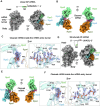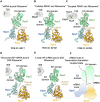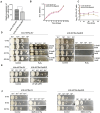Bacterial Rps3 counters oxidative and UV stress by recognizing and processing AP-sites on mRNA via a novel mechanism
- PMID: 39588766
- PMCID: PMC11662941
- DOI: 10.1093/nar/gkae1130
Bacterial Rps3 counters oxidative and UV stress by recognizing and processing AP-sites on mRNA via a novel mechanism
Abstract
Lesions and stable secondary structures in mRNA severely impact the translation efficiency, causing ribosome stalling and collisions. Prokaryotic ribosomal proteins Rps3, Rps4 and Rps5, located in the mRNA entry tunnel, form the mRNA helicase center and unwind stable mRNA secondary structures during translation. However, the mechanism underlying the detection of lesions on translating mRNA is unclear. We used Cryo-EM, biochemical assays, and knockdown experiments to investigate the apurinic/apyrimidinic (AP) endoribonuclease activity of bacterial ribosomes on AP-site containing mRNA. Our biochemical assays show that Rps3, specifically the 130RR131 motif, is important for recognizing and performing the AP-endoribonuclease activity. Furthermore, structural analysis revealed cleaved mRNA product in the 30S ribosome entry tunnel. Additionally, knockdown studies in Mycobacterium tuberculosis confirmed the protective role of Rps3 against oxidative and UV stress. Overall, our results show that prokaryotic Rps3 recognizes and processes AP-sites on mRNA via a novel mechanism that is distinct from eukaryotes.
© The Author(s) 2024. Published by Oxford University Press on behalf of Nucleic Acids Research.
Figures










Similar articles
-
RpS3 translation is repressed by interaction with its own mRNA.J Cell Biochem. 2010 May 15;110(2):294-303. doi: 10.1002/jcb.22537. J Cell Biochem. 2010. PMID: 20217897
-
Multi-protein bridging factor 1(Mbf1), Rps3 and Asc1 prevent stalled ribosomes from frameshifting.Elife. 2018 Nov 22;7:e39637. doi: 10.7554/eLife.39637. Elife. 2018. PMID: 30465652 Free PMC article.
-
Interactions between the mRNA and Rps3/uS3 at the entry tunnel of the ribosomal small subunit are important for no-go decay.PLoS Genet. 2018 Nov 26;14(11):e1007818. doi: 10.1371/journal.pgen.1007818. eCollection 2018 Nov. PLoS Genet. 2018. PMID: 30475795 Free PMC article.
-
Unique structural features of the Mycobacterium ribosome.Prog Biophys Mol Biol. 2020 May;152:15-24. doi: 10.1016/j.pbiomolbio.2019.12.001. Epub 2019 Dec 10. Prog Biophys Mol Biol. 2020. PMID: 31858996 Review.
-
The discovery of mRNA interferases: implication in bacterial physiology and application to biotechnology.J Cell Physiol. 2006 Dec;209(3):670-6. doi: 10.1002/jcp.20801. J Cell Physiol. 2006. PMID: 17001682 Review.
References
MeSH terms
Substances
Grants and funding
LinkOut - more resources
Full Text Sources
Miscellaneous

